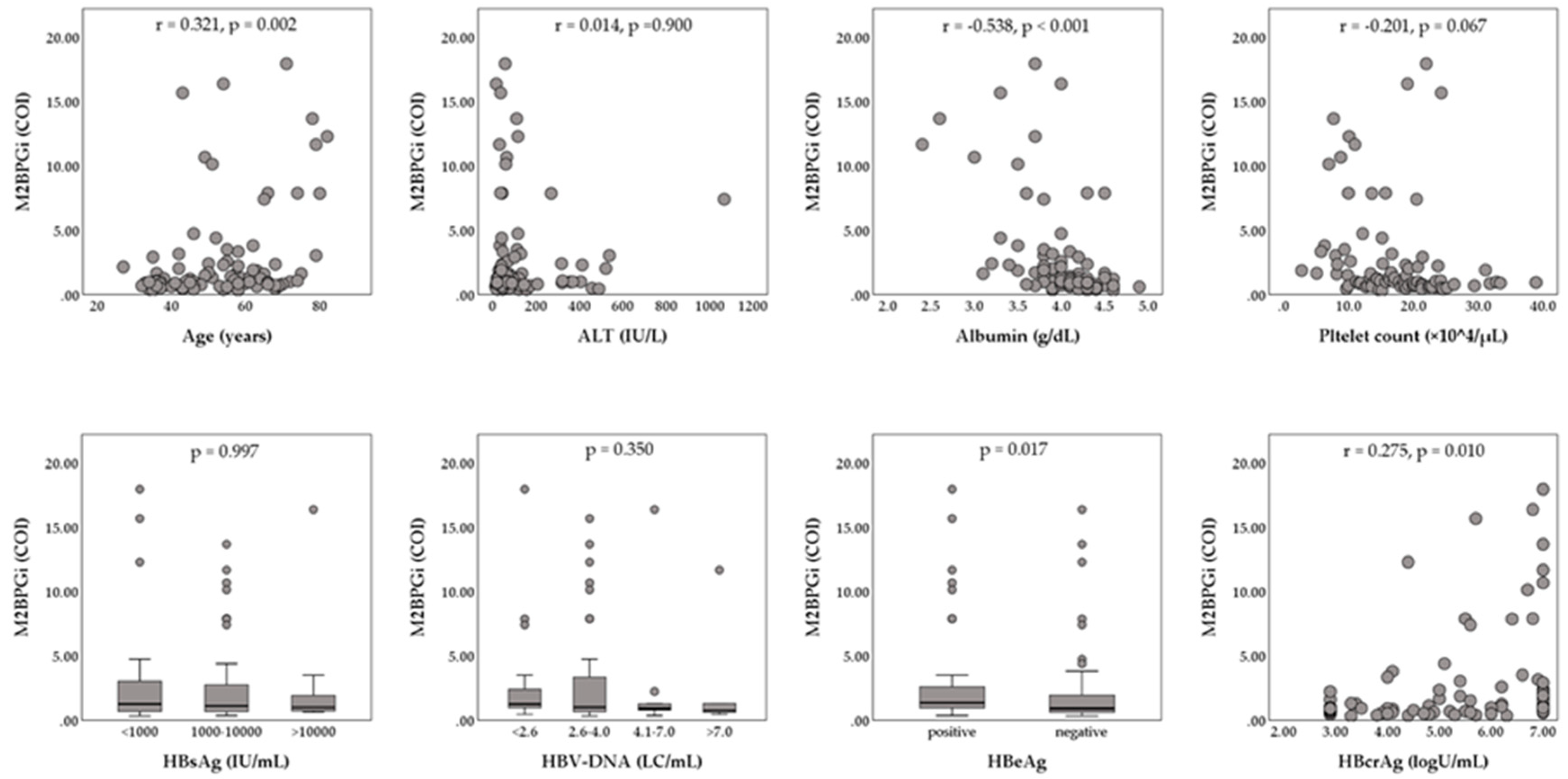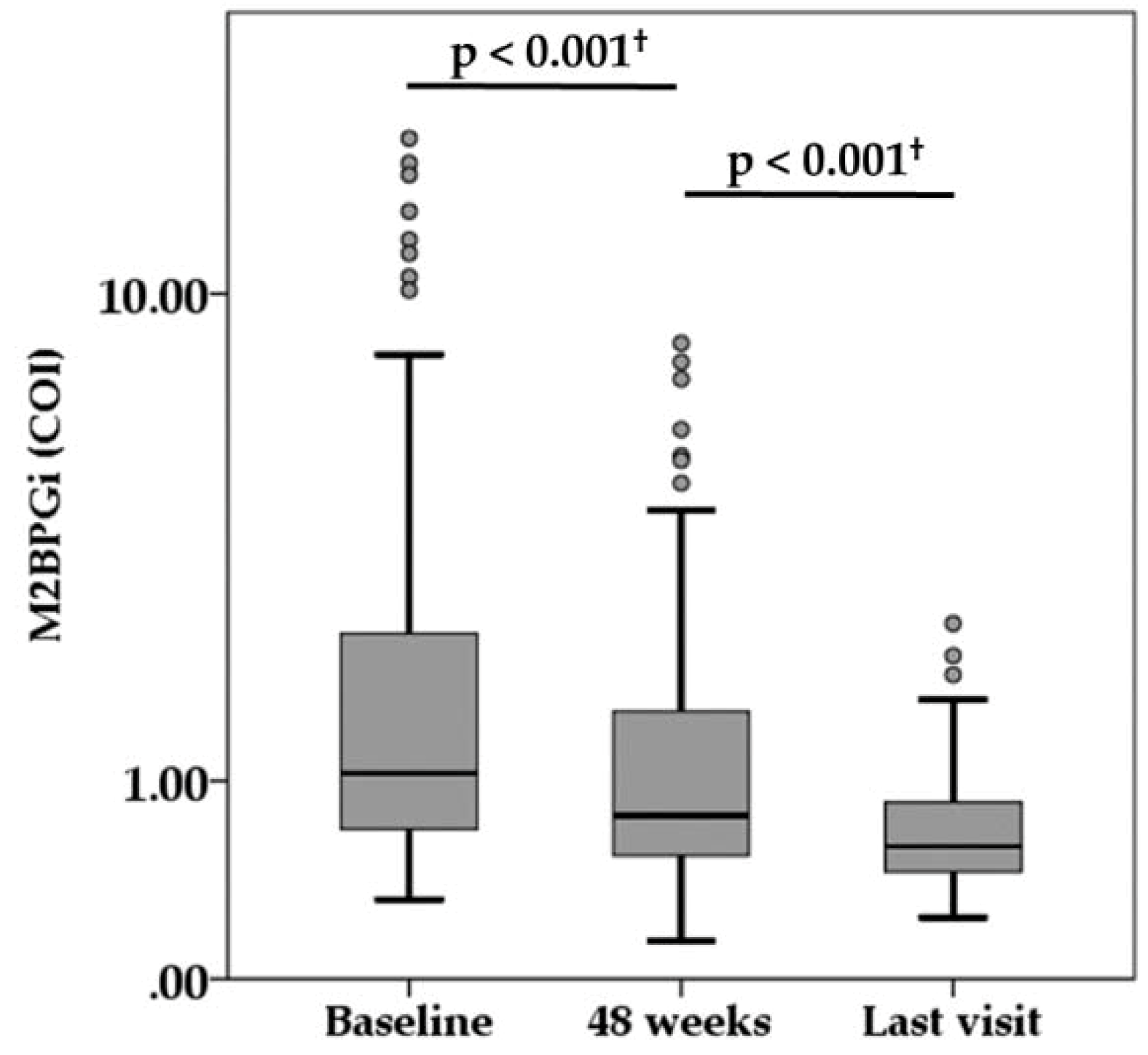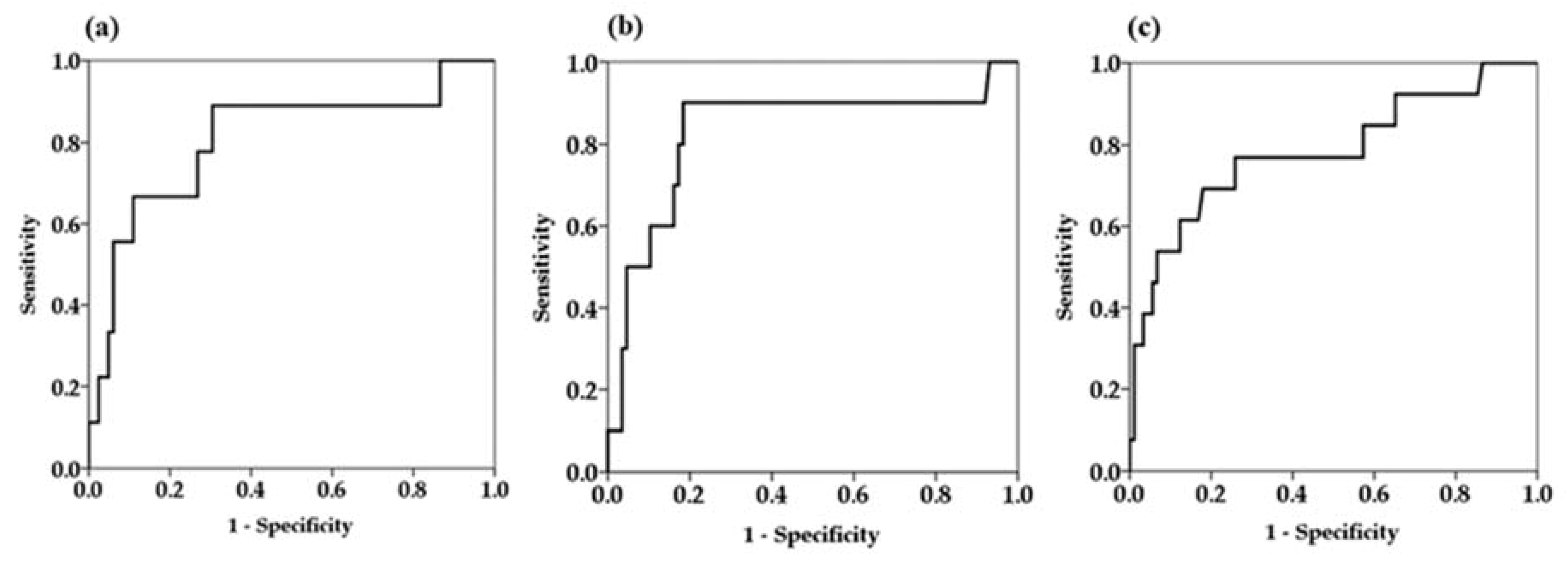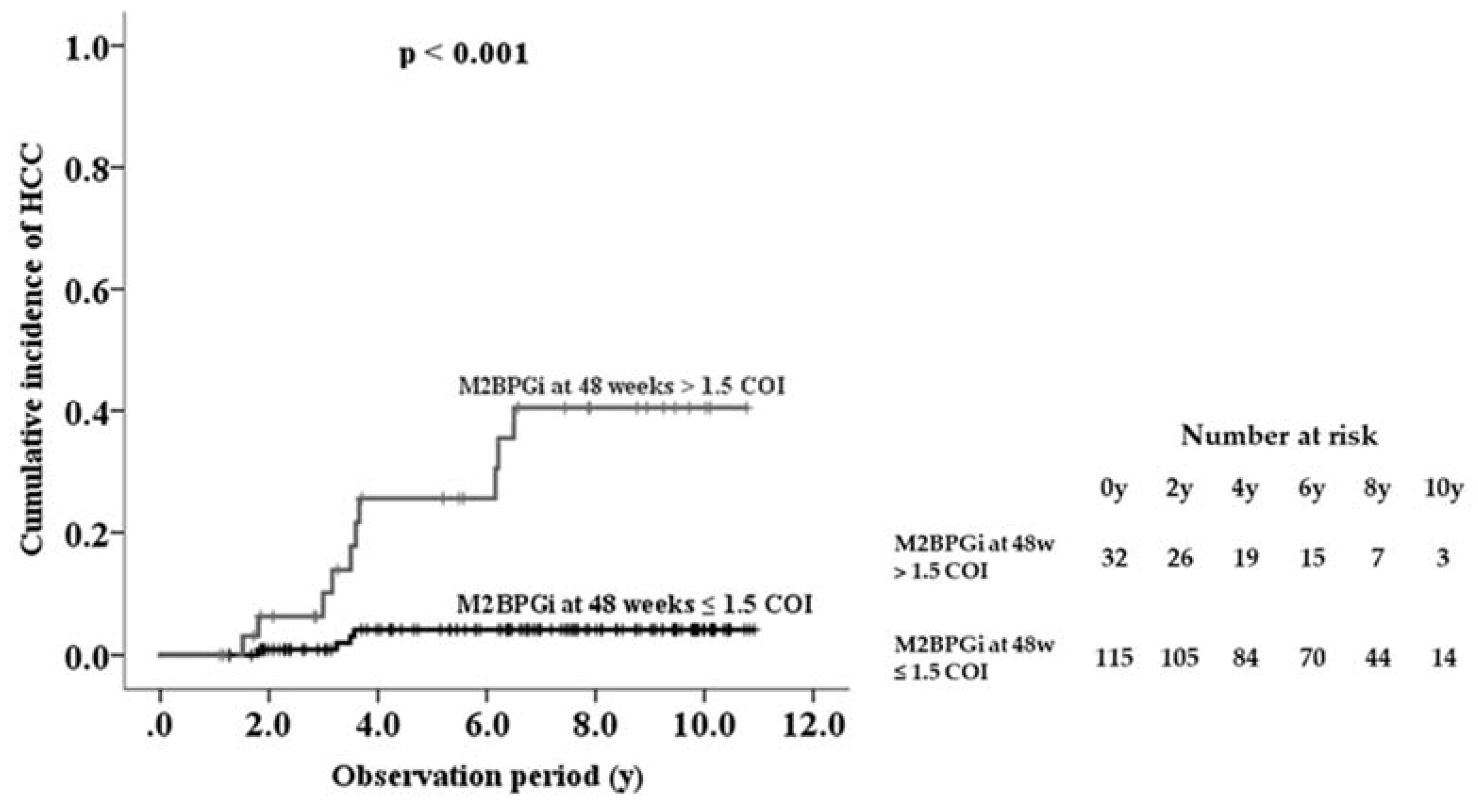On-treatment Serum Mac-2 Binding Protein Glycosylation Isomer (M2BPGi) Level and Risk of Hepatocellular Carcinoma Development in Patients with Chronic Hepatitis B during Nucleot(s)ide Analogue Therapy
Abstract
1. Introduction
2. Results
2.1. Baseline Patients’ Characteristics
2.2. Virologic and Biochemical Response during NA Treatment
2.3. HCC Development and Risk Analysis
2.4. Serum M2BPGi Level and HCC Development
3. Discussion
4. Materials and Methods
4.1. Patients
4.2. Laboratory Investigations
4.3. Patient Follow-Up
4.4. Statistical Analyses
5. Conclusions
Author Contributions
Funding
Conflicts of Interest
Abbreviations
| ADV | adefovir dipivoxil |
| ALT | alanine aminotransferase |
| AUROC | area under receiver operator characteristic curve |
| CHB | chronic hepatitis B |
| CI | confidence interval |
| COI | cut-off index |
| ETV | entecavir |
| HBcrAg | hepatitis B core-related antigen |
| HBeAg | hepatitis B e-antigen |
| HBsAg | hepatitis B surface antigen |
| HBV | hepatitis B virus |
| HCC | hepatocellular carcinoma |
| HR | hazard ratio |
| LAM | lamivudine |
| LC | log copies |
| M2BPGi | Mac-2-binding protein glycation isomer |
| NA | nucleot(s)ide analogue |
| NPV | negative predictive value |
| PPV | positive predictive value |
| TDF | tenofovir disoproxil fumarate |
| ROC | receiver operating curve |
References
- Lee, W.M. Hepatitis B virus infection. N. Engl. J. Med. 1997, 337, 1733–1745. [Google Scholar] [CrossRef] [PubMed]
- Ganem, D. Prince AM. Hepatitis B virus infection—natural history and clinical consequence. N. Engl. J. Med. 2004, 350, 1118–1129. [Google Scholar] [CrossRef] [PubMed]
- Chang, T.T.; Liaw, Y.F.; Wu, S.S.; Schiff, E.; Han, K.H.; Lai, C.L.; Safadi, R.; Lee, S.S.; Halota, W.; Goodman, Z.; et al. Long-term entecavir therapy results in the reversal of fibrosis/cirrhosis and continued histological improvement in patients with chronic hepatitis B. Hepatology 2010, 52, 886–893. [Google Scholar] [CrossRef] [PubMed]
- Marcellin, P.; Gane, E.; Buti, M.; Afdhal, N.; Sievert, W.; Jacobson, I.M.; Washington, M.K.; Germanidis, G.; Flaherty, J.F.; Aguilar Schall, R.; et al. Regression of cirrhosis during treatment with tenofovir disoproxil fumarate for chronic hepatitis B: A 5-year open-label follow-up study. Lancet 2013, 381, 468–475. [Google Scholar] [CrossRef]
- Liaw, Y.F.; Sung, J.J.; Chow, W.C.; Farrell, G.; Lee, C.Z.; Yuen, H.; Tanwandee, T.; Tao, Q.M.; Shue, K.; Keene, O.N.; et al. Lamivudine for patients with chronic hepatitis B and advanced liver disease. N. Engl. J. Med. 2004, 351, 1521–1531. [Google Scholar] [CrossRef]
- Hosaka, T.; Suzuki, F.; Kobayashi, M.; Seko, Y.; Kawamura, Y.; Sezaki, H.; Akuta, N.; Suzuki, Y.; Saitoh, S.; Arase, Y.; et al. Long-term entecavir treatment reduces hepatocellular carcinoma incidence in patients with hepatitis B virus infection. Hepatology 2013, 58, 98–107. [Google Scholar] [CrossRef]
- Pungpapong, S.; Kim, W.R.; Poterucha, J.J. Natural history of hepatitis B virus infection: An update for clinicians. Mayo Clin. Proc. 2007, 82, 967–975. [Google Scholar] [CrossRef]
- Bravo, A.A.; Sheth, S.G.; Chopra, S. Liver biopsy. N. Engl. J. Med. 2001, 344, 495–500. [Google Scholar] [CrossRef]
- Bedossa, P.; Dargère, D.; Paradis, V. Sampling variability of liver fibrosis in chronic hepatitis C. Hepatology 2003, 38, 1449–1457. [Google Scholar] [CrossRef]
- Rousselet, M.C.; Michalak, S.; Dupré, F.; Croué, A.; Bedossa, P.; Saint-André, J.P.; Calès, P. Hepatitis Network 49. Sources of variability in histological scoring of chronic viral hepatitis. Hepatology 2005, 41, 257–264. [Google Scholar] [CrossRef]
- Kuno, A.; Ikehara, Y.; Tanaka, Y.; Ito, K.; Matsuda, A.; Sekiya, S.; Hige, S.; Sakamoto, M.; Kage, M.; Mizokami, M.; et al. A serum “sweet-doughnut” protein facilitates fibrosis evaluation and therapy assessment in patients with viral hepatitis. Sci. Rep. 2013, 3, 1065. [Google Scholar] [CrossRef] [PubMed]
- Toshima, T.; Shirabe, K.; Ikegami, T.; Yoshizumi, T.; Kuno, A.; Togayachi, A.; Gotoh, M.; Narimatsu, H.; Korenaga, M.; Mizokami, M.; et al. A novel serum marker, glycosylated Wisteria floribunda agglutinin-positive Mac-2 binding protein (WFA(+)-M2BP), for assessing liver fibrosis. J. Gastroenterol. 2015, 50, 76–84. [Google Scholar] [CrossRef] [PubMed]
- Yamasaki, K.; Tateyama, M.; Abiru, S.; Komori, A.; Nagaoka, S.; Saeki, A.; Bekki, S.; Kugiyama, Y.; Miyazoe, Y.; Kuno, A.; et al. Elevated serum levels of Wisteria floribunda agglutinin-positive human Mac-2 binding protein predict the development of hepatocellular carcinoma in hepatitis C patients. Hepatology 2014, 60, 1563–1570. [Google Scholar] [CrossRef] [PubMed]
- Sato, S.; Genda, T.; Ichida, T.; Amano, N.; Sato, S.; Murata, A.; Tsuzura, H.; Narita, Y.; Kanemitsu, Y.; Hirano, K.; et al. Prediction of Hepatocellular Carcinoma Development after Hepatitis C Virus Eradication Using Serum Wisteria floribunda Agglutinin-Positive Mac-2-Binding Protein. Int. J. Mol. Sci. 2016, 17, 2143. [Google Scholar] [CrossRef] [PubMed]
- Kawaguchi, K.; Honda, M.; Ohta, H.; Terashima, T.; Shimakami, T.; Arai, K.; Yamashita, T.; Sakai, Y.; Yamashita, T.; Mizukoshi, E.; et al. Serum Wisteria floribunda agglutinin-positive Mac-2 binding protein predicts hepatocellular carcinoma incidence and recurrence in nucleos(t)ide analogue therapy for chronic hepatitis B. J. Gastroenterol. 2018, 53, 740–751. [Google Scholar] [CrossRef]
- Chen, C.J.; Yang, H.I.; Su, J.; Jen, C.L.; You, S.L.; Lu, S.N.; Huang, G.T.; Iloeje, U.H. REVEAL-HBV Study Group. Risk of hepatocellular carcinoma across a biological gradient of serum hepatitis B virus DNA level. JAMA 2006, 295, 65–73. [Google Scholar] [CrossRef]
- Orito, E.; Hasebe, C.; Kurosaki, M.; Osaki, Y.; Joko, K.; Watanabe, H.; Kimura, H.; Nishijima, N.; Kusakabe, A.; Izumi, N.; et al. Risk of hepatocellular carcinoma in cirrhotic hepatitis B virus patients during nucleoside/nucleotide analog therapy. Hepatol. Res. 2015, 45, 872–879. [Google Scholar] [CrossRef]
- Kim, G.A.; Han, S.; Kim, H.D.; An, J.; Lim, Y.S. Higher risk of hepatocellular carcinoma in chronic hepatitis B vs chronic hepatitis C after achievement of virologic response. J. Viral. Hepat. 2017, 24, 990–997. [Google Scholar] [CrossRef]
- Morio, K.; Imamura, M.; Daijo, K.; Teraoka, Y.; Honda, F.; Nakamura, Y.; Kobayashi, T.; Nakahara, T.; Nagaoki, Y.; Kawaoka, T.; et al. Wisteria floribunda agglutinin positive Mac-2-binding protein level increases in patients with acute liver injury. J. Gastroenterol. 2017, 52, 1252–1257. [Google Scholar] [CrossRef]
- Sasaki, R.; Yamasaki, K.; Abiru, S.; Komori, A.; Nagaoka, S.; Saeki, A.; Hashimoto, S.; Bekki, S.; Kugiyama, Y.; Kuno, A.; et al. Serum Wisteria Floribunda Agglutinin-Positive Mac-2 Binding Protein Values Predict the Development of Hepatocellular Carcinoma among Patients with Chronic Hepatitis C after Sustained Virological Response. PLoS ONE 2015, 10, e0129053. [Google Scholar] [CrossRef]
- Drafting Committee for Hepatitis Management Guidelines and the Japan Society of Hepatology. JSH guidelines for the management of hepatitis B virus infection. Hepatol. Res. 2014, 44, 1–58. [Google Scholar] [CrossRef]




| Baseline | 48 Weeks | Last Visit | p-Value | ||
|---|---|---|---|---|---|
| HBsAg | |||||
| <1000 IU/mL | 23.2% | 29.8% | 43.1% | <0.001‡ | |
| 1000–10,000 IU/mL | 52.8% | 58.8% | 48.5% | ||
| >10000 IU/mL | 24.0% | 11.4% | 8.5% | ||
| HBV-DNA | |||||
| < 2.6 LC/mL | 6.8% | 75.5% | 88.0% | <0.001 ‡ | |
| 2.6–4.0 LC/mL | 10.3% | 14.7% | 9.8% | ||
| 4.1–7.0 LC/mL | 41.8% | 9.1% | 1.5% | ||
| >7.0 LC/mL | 41.1% | 0.7% | 0.7% | ||
| HBeAg positivity | 51.2% | 40.8% | 18.3% | <0.001 ‡ | |
| HBcrAg (logU/mL) † | 5.6 (2.9–7.0) | 4.6 (2.9–7.0) | 3.5 (2.9–7.0) | <0.001 § | |
| ALT (IU/L) † | 63 (14–1712) | 24 (8–571) | 18 (5–173) | <0.001 § | |
| Albumin (g/dL) † | 4.1 (2.3–4.9) | 4.2 (2.6–4.9) | 4.2 (3.0–4.9) | 0.004 § | |
| Platelet count (×104/µL) † | 17.8 (2.8–38.9) | 16.2 (5.7–29.3) | 17.2 (5.1–38.2) | 0.026 § | |
| M2BPGi (COI) † | 1.06 (0.32–17.95) | 0.77 (0.14–8.25) | 0.59 (0.24–6.57) | <0.001 § | |
| Univariate | Multivariate | |||
|---|---|---|---|---|
| Variables | HR (95%CI) | p-Value | HR (95%CI) | p-Value |
| Baseline | ||||
| Age | 1.08 (1.03–1.13) | 0.001 | ||
| Male | 1.34 (0.42–4.27) | 0.622 | 0.268 | |
| Cirrhosis | 4.50 (1.58–12.87) | 0.005 | 0.261 | |
| HBV-DNA | 0.93 (0.72–1.21) | 0.585 | ||
| HBsAg | 1.00 (1.00–1.00) | 0.132 | ||
| HBeAg positivity | 1.68 (0.55–5.13) | 0.365 | ||
| HBcrAg | 1.09 (0.70–1.70) | 0.703 | ||
| ALT | 0.99 (0.98–1.00) | 0.178 | ||
| Albumin | 0.43 (0.16–1.14) | 0.089 | 0.926 | |
| Platelet count | 0.87 (0.80–0.96) | 0.004 | 0.181 | |
| M2BPGi | 1.18 (1.07–1.30) | 0.001 | 0.719 | |
| 48 weeks | ||||
| HBV-DNA | 1.02 (0.73–1.44) | 0.903 | ||
| HBsAg | 1.00 (1.00–1.00) | 0.139 | ||
| HBeAg positivity | 1.03 (0.34–3.14) | 0.961 | ||
| HBcrAg | 0.97 (0.65–1.45) | 0.896 | ||
| ALT | 1.00 (0.99–1.02) | 0.937 | ||
| Albumin | 0.14 (0.04–0.47) | 0.002 | 0.142 | |
| Platelet count | 0.89 (0.80–0.98) | 0.022 | 0.230 | |
| M2BPGi | 1.61 (1.28–2.03) | <0.001 | 1.95 (1.39–2.72) | <0.001 |
| Last visit | ||||
| NA switch/add-on | 0.54 (0.12–2.43) | 0.424 | ||
| HBV-DNA | 1.29 (0.94–1.76) | 0.120 | ||
| HBsAg | 1.00 (1.00–1.00) | 0.339 | ||
| HBeAg positivity | 2.70 (0.84–8.65) | 0.094 | 0.255 | |
| HBcrAg | 1.22 (0.76–1.96) | 0.419 | ||
| ALT | 1.00 (0.95–1.03) | 0.511 | ||
| Albumin | 0.54 (0.15–1.96) | 0.348 | ||
| Platelet count | 0.93 (0.85–1.02) | 0.117 | ||
| M2BPGi | 1.84 (1.40–2.41) | <0.001 | 0.858 | |
| Time Point | Cutoff | AUROC | Sensitivity | Specificity | PPV | NPV |
|---|---|---|---|---|---|---|
| Baseline | 1.5 COI | 0.805 | 0.889 | 0.685 | 0.889 | 0.695 |
| 48 weeks | 1.5 COI | 0.829 | 0.900 | 0.803 | 0.800 | 0.804 |
| Last visit | 0.8 COI | 0.816 | 0.692 | 0.787 | 0.692 | 0.786 |
© 2020 by the authors. Licensee MDPI, Basel, Switzerland. This article is an open access article distributed under the terms and conditions of the Creative Commons Attribution (CC BY) license (http://creativecommons.org/licenses/by/4.0/).
Share and Cite
Murata, A.; Amano, N.; Sato, S.; Tsuzura, H.; Tomishima, K.; Sato, S.; Matsumoto, K.; Shimada, Y.; Iijima, K.; Genda, T. On-treatment Serum Mac-2 Binding Protein Glycosylation Isomer (M2BPGi) Level and Risk of Hepatocellular Carcinoma Development in Patients with Chronic Hepatitis B during Nucleot(s)ide Analogue Therapy. Int. J. Mol. Sci. 2020, 21, 2051. https://doi.org/10.3390/ijms21062051
Murata A, Amano N, Sato S, Tsuzura H, Tomishima K, Sato S, Matsumoto K, Shimada Y, Iijima K, Genda T. On-treatment Serum Mac-2 Binding Protein Glycosylation Isomer (M2BPGi) Level and Risk of Hepatocellular Carcinoma Development in Patients with Chronic Hepatitis B during Nucleot(s)ide Analogue Therapy. International Journal of Molecular Sciences. 2020; 21(6):2051. https://doi.org/10.3390/ijms21062051
Chicago/Turabian StyleMurata, Ayato, Nozomi Amano, Sho Sato, Hironori Tsuzura, Ko Tomishima, Shunsuke Sato, Kohei Matsumoto, Yuji Shimada, Katsuyori Iijima, and Takuya Genda. 2020. "On-treatment Serum Mac-2 Binding Protein Glycosylation Isomer (M2BPGi) Level and Risk of Hepatocellular Carcinoma Development in Patients with Chronic Hepatitis B during Nucleot(s)ide Analogue Therapy" International Journal of Molecular Sciences 21, no. 6: 2051. https://doi.org/10.3390/ijms21062051
APA StyleMurata, A., Amano, N., Sato, S., Tsuzura, H., Tomishima, K., Sato, S., Matsumoto, K., Shimada, Y., Iijima, K., & Genda, T. (2020). On-treatment Serum Mac-2 Binding Protein Glycosylation Isomer (M2BPGi) Level and Risk of Hepatocellular Carcinoma Development in Patients with Chronic Hepatitis B during Nucleot(s)ide Analogue Therapy. International Journal of Molecular Sciences, 21(6), 2051. https://doi.org/10.3390/ijms21062051





